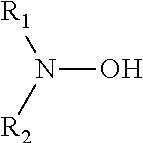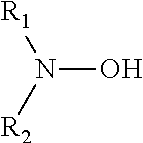Enzymatic pretreatment of wood in a method for producing mechanical paper pulp
a technology of mechanical paper pulp and pretreatment method, which is applied in the field of mechanical paper pulp production, can solve the problems of high energy consumption of mechanical refining, substantial cost, and 3000 kwh per metric ton of mechanical pulp produced, and achieve the effect of enhancing the whiteness of said pulp and lowering the energy consumption of the method
- Summary
- Abstract
- Description
- Claims
- Application Information
AI Technical Summary
Benefits of technology
Problems solved by technology
Method used
Image
Examples
examples
The examples which follow illustrate the invention without limiting it.
The starting materials used are as follows:
[0153]fresh Norwegian spruce chips, supplied by the Holmen company,[0154]chips from fresh poplar logs, supplied by a forestry enterprise in the Lyons region,[0155]fresh Spanish eucalyptus chips, supplied by the Ence company,[0156]Myceliophthora laccases sold by the Novozymes company under reference NS51003, having an activity of 1000 LAMU / mL as measured in accordance with the protocol indicated above,[0157]diethylhydroxylamine (DEHA) sold by the Arkema company,[0158]4-hydroxy-3,5-dimethoxybenzaldehyde (syringaldehyde),[0159]diethylene triamine pentaacetic acid (DTPA),[0160]hydrogen peroxide,[0161]sodium silicate,[0162]sodium hydroxide,[0163]magnesium sulfate.
Table 1: Impregnating Composition
[0164]For each test, an impregnating composition in accordance with table 1 is prepared (the percentages are given by weight relative to the total weight of the composition). For this...
PUM
| Property | Measurement | Unit |
|---|---|---|
| time | aaaaa | aaaaa |
| temperature | aaaaa | aaaaa |
| time | aaaaa | aaaaa |
Abstract
Description
Claims
Application Information
 Login to View More
Login to View More - R&D
- Intellectual Property
- Life Sciences
- Materials
- Tech Scout
- Unparalleled Data Quality
- Higher Quality Content
- 60% Fewer Hallucinations
Browse by: Latest US Patents, China's latest patents, Technical Efficacy Thesaurus, Application Domain, Technology Topic, Popular Technical Reports.
© 2025 PatSnap. All rights reserved.Legal|Privacy policy|Modern Slavery Act Transparency Statement|Sitemap|About US| Contact US: help@patsnap.com



